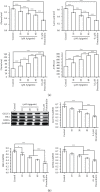Apigenin Suppresses the Warburg Effect and Stem-like Properties in SOSP-9607 Cells by Inactivating the PI3K/Akt/mTOR Signaling Pathway
- PMID: 35310040
- PMCID: PMC8926538
- DOI: 10.1155/2022/3983637
Apigenin Suppresses the Warburg Effect and Stem-like Properties in SOSP-9607 Cells by Inactivating the PI3K/Akt/mTOR Signaling Pathway
Abstract
Osteosarcoma (OS) is a prevalent primary malignant bone tumor that commonly occurs in children and adolescents. Apigenin (4',5,7-trihydroxyflavone) is one of the most researched phenolic compounds that exhibits antitumor effects in several cancers. The aim of the current study was to investigate the effect and underlying mechanisms of apigenin on OS. To address this, OS cells (SOSP-9607) were treated with different concentrations of apigenin. The proliferation, migration, invasion, stem-like properties, and Warburg effect of apigenin-treated OS cells were evaluated. Apigenin was found to suppress the proliferation of SOSP-9607 cells and inhibit epithelial-mesenchymal transition, as indicated by decreased number of migrated and invaded cells, decreased protein expression of vimentin, and increased protein expression of E-cadherin. Additionally, apigenin suppressed tumorsphere formation and reduced the proportion of SOSP-9607 cells with positive expression of the stem cell-related markers Nanog and OCT-4. Apigenin inhibited the Warburg effect in SOSP-9607 cells, as demonstrated by decreased glucose and lactic acid levels, increased citrate and ATP levels, and downregulation of GLUT1, HK1, and LDHA, which are metabolism-related enzymes related to the Warburg effect. Moreover, apigenin inhibited the phosphorylation of PI3K, Akt, and mTOR in SOSP-9607 cells. Collectively, these results indicate that apigenin suppresses the Warburg effect and stem-like properties in SOSP-9607 cells, which may be mediated by PI3K/Akt/mTOR signaling, thus, providing a novel strategy for OS treatment.
Copyright © 2022 Yihua Shi et al.
Conflict of interest statement
All authors declare that they have no conflicts of interest.
Figures





Similar articles
-
KLK6 mediates stemness and metabolism of gastric carcinoma cells via the PI3K/AKT/mTOR signaling pathway.Oncol Lett. 2021 Dec;22(6):824. doi: 10.3892/ol.2021.13085. Epub 2021 Oct 12. Oncol Lett. 2021. PMID: 34691251 Free PMC article.
-
LncRNA FER1L4 induces apoptosis and suppresses EMT and the activation of PI3K/AKT pathway in osteosarcoma cells via inhibiting miR-18a-5p to promote SOCS5.Gene. 2019 Dec 30;721:144093. doi: 10.1016/j.gene.2019.144093. Epub 2019 Aug 29. Gene. 2019. PMID: 31473323
-
MiR-21-5p inhibition attenuates Warburg effect and stemness maintenance in osteosarcoma cells via inactivation of Wnt/β-catenin signaling.Acta Biochim Pol. 2021 Oct 25;68(4):725-732. doi: 10.18388/abp.2020_5631. Acta Biochim Pol. 2021. PMID: 34694765
-
Effects of miR-202-5p silencing PIK3CA gene expression on proliferation, invasion, and epithelial-mesenchymal transition of cervical cancer SiHa cells through inhibiting PI3K/Akt/mTOR signaling pathway activation.Mol Cell Biochem. 2021 Nov;476(11):4031-4044. doi: 10.1007/s11010-021-04211-4. Epub 2021 Jul 9. Mol Cell Biochem. 2021. PMID: 34244973
-
Anticancer Effects and Molecular Mechanisms of Apigenin in Cervical Cancer Cells.Cancers (Basel). 2022 Apr 4;14(7):1824. doi: 10.3390/cancers14071824. Cancers (Basel). 2022. PMID: 35406599 Free PMC article.
Cited by
-
Phytochemicals as Regulators of Tumor Glycolysis and Hypoxia Signaling Pathways: Evidence from In Vitro Studies.Pharmaceuticals (Basel). 2022 Jun 28;15(7):808. doi: 10.3390/ph15070808. Pharmaceuticals (Basel). 2022. PMID: 35890106 Free PMC article. Review.
-
Interferon-γ Stimulates Interleukin-27 Derived from Dendritic Cells to Regulate Th9 Differentiation through STAT1/3 Pathway.Dis Markers. 2022 Oct 18;2022:1542112. doi: 10.1155/2022/1542112. eCollection 2022. Dis Markers. 2022. PMID: 36304255 Free PMC article.
-
Caudatin Inhibits the Proliferation, Invasion, and Glycolysis of Osteosarcoma Cells via the Wnt/β- Catenin Pathway.Evid Based Complement Alternat Med. 2022 Dec 23;2022:4026688. doi: 10.1155/2022/4026688. eCollection 2022. Evid Based Complement Alternat Med. 2022. PMID: 36588592 Free PMC article.
-
The Potential Role of Apigenin in Cancer Prevention and Treatment.Molecules. 2022 Sep 16;27(18):6051. doi: 10.3390/molecules27186051. Molecules. 2022. PMID: 36144783 Free PMC article. Review.
-
The roles of glycolysis in osteosarcoma.Front Pharmacol. 2022 Aug 17;13:950886. doi: 10.3389/fphar.2022.950886. eCollection 2022. Front Pharmacol. 2022. PMID: 36059961 Free PMC article. Review.
References
-
- Qin Y. D., Fang F. M., Zhou J. J. Atranones from Stachybotrys chartarum and their antitumor activities in MG-63 human osteosarcoma cells. Fitoterapia . 2020;146104727 - PubMed
-
- Clark J. C., Dass C. R., Choong P. F. A review of clinical and molecular prognostic factors in osteosarcoma. Journal of Cancer Research and Clinical Oncology . 2008;134(3):281–297. - PubMed
-
- Asnafi A. A., Behzad M. M., Ghanavat M., Shahjahani M., Saki N. Singe nucleotide polymorphisms in osteosarcoma: pathogenic effect and prognostic significance. Experimental and Molecular Pathology . 2019;106:63–77. - PubMed
LinkOut - more resources
Full Text Sources
Research Materials
Miscellaneous

